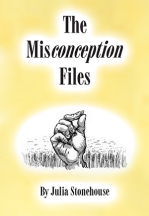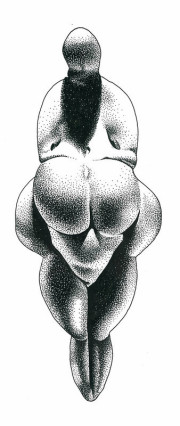Every person who ever lived wonders "where did I come from?" and the amazing thing is that until 1900 AD nobody knew. In ignorance, people lived with ideas that were fundamentally wrong.
And those ideas led to profoundly incorrect notions about the 'nature' of men, and the 'nature' of women.
-------------------------------------------------------
In the UK the book is available at the link below. Otherwise see Amazon USA, France, Spain, Germany or Italy.
Parthenogenetic women - who reproduce on their own
Farming began around 10,000 BC and, before this, seeds did not have the significance they had later. Seed was food, certainly, but not the source of future crops. That future discovery would become known as 'the agricultural revolution'. So what happened before anyone thought about 'seed'?
We now have quite a collection of material dated between 35,000-10,000 BC, which is from a time known as the Upper Paleolithic. It's amazing anything still exists from 35,000 years ago and you can imagine how far down archaeologists have to dig to find it. The material falls into three main groups: portable objects; paintings on cave walls often deep underground; and wall art in rock shelters near ground level. Human images are overwhelmingly female, either depicted as a whole person, or in body parts - in particular, vulvas, protruding abdomens, and breasts. In other words, women's reproductive parts.
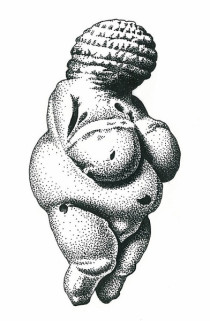 Venus of Willendorf 30,000-27,000 BC limestone figurine. Found near Krems, Austria (Naturhistorisches Museum, Vienna, Austria).
Venus of Willendorf 30,000-27,000 BC limestone figurine. Found near Krems, Austria (Naturhistorisches Museum, Vienna, Austria).
120 human statuettes dated earlier than 10,000 BC have been found, of which only one is agreed by experts to be male: the Brno 'puppet' found in a shamans grave. The rest are probably female.
As a group, the female figurines from this period come from a vast geographical area stretching from southern France to south-eastern Russia, just above Mongolia. These little naked female bodies were made from bone, ivory, rock, limestone, and even, as long ago as 27,000 BC, a primitive form of baked ceramic.
They range in size but most are small enough to fit in a hand. They’re remarkably similar in that they seldom have facial features – although the hair is
sometimes elaborately carved. Some are skinny and flat-chested, but most have large, pendulous breasts, a very pronounced vulva, and a great deal of body fat, possibly a sign of abundance in freezing
and uncertain times.
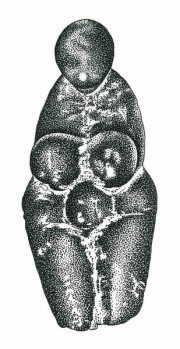 Venus of Menton 30,000-27,000 BC soapstone figurine found on Mediterranean coast France/Italy border (Musee des Antiquites Nationales, Paris, France).
Venus of Menton 30,000-27,000 BC soapstone figurine found on Mediterranean coast France/Italy border (Musee des Antiquites Nationales, Paris, France).
The female figurines seldom have feet, as if they were intended to be placed in the ground, like an idol. Many have, instead of a head, a bump with a hole so they could be used as a pendant. They were made small enough to carry from place to place and the impressive artistry in their making shows how important the female image was to people throughout a huge geographic area.
What were these female images meant to represent? They may have represented female relatives long dead, from whom the tribes originated - the first ancestor.
Or, they might have represented the concept of an earth mother, the Creatrix, she who gives birth to all - people and animals, plants, moon and sun, from the belly of the earth, just as women give
birth from their vulvas. In either case, they represent the concept of females who reproduce without males - parthenogenetic women.
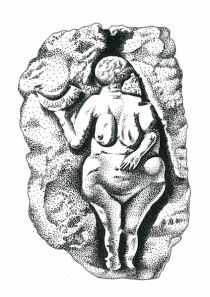 Venus of Laussel 25,000-20,000 BC, low-relief in limestone, rock shelter, France (Musee d'Aquitaine, Bordeaux, France).
Venus of Laussel 25,000-20,000 BC, low-relief in limestone, rock shelter, France (Musee d'Aquitaine, Bordeaux, France).
The earliest drawing of a human being was found in the Chauvet Cave in France and is dated 30,35,000 BC. In the deepest part of the cave, 400 meters (1310 feet) from the entrance, our ancient ancestors painted in black pigment a 3 foot high vulva on a cone of limestone hanging from the ceiling. It has the shape of the figure to the right, if you can imagine it from the abdomen to below the knees. Four other small vulvas were drawn in this cave complex. By comparison, there are no images of men or male parts. On the limestone cone, near the vulva, a musk oxen has also been drawn. It has been descibed as a 'sorcerer' but it has absolutely no human features.
Nearby there is a 5 foot high fissure in the wall that, because of the folds in the rock, looks like a huge vulva. A variety of about 30 animals have been drawn both entering and leaving this deep recess in the wall.
Paleolithic cave art is symbolic: people didn't do this art just for fun; it had a spiritual purpose. Fissures in other caves have been similarly decorated, and some of them are dripping with red hematite - iron oxide - percolating through from the earth above with rainwater. These look like vulvas menstruating.
It seems quite possible from these artworks that people thought in terms of the earth giving life to all, and saw that earth as female. If so, they would also think in terms of women reproducing alone, without men.
Sex or reproduction?
Sex does not equate with reproduction, and reproduction does not equate with sex. To us, it might. But we should not project that link back in time. Anthropology taught us that. However, I've read more times than I care to remember ideas around these images of naked women (which are also on cave walls) being early pornography. Perhaps the no-face feature of these times is supposed to be the equivalent of women with paper bags over their heads? Another rather predictable view is that they somehow represent "fertility": that they are perhaps amulets to ensure the production of babies both human and animal; protection in childbirth; or they have some other purpose that neatly fits womankind into that box the patriarchal man feels so comfortable with - women are about having babies (and sex with). With women inside this box, nothing more interesting or powerful is possible for them.
If the naked female statuettes and the images of vulvas, enlarged abdomens, and breasts painted and etched on cave walls were about sex, you might expect to find images of intercourse, or male and female symbols joined, or similarly powerful representations of men. In my book THE MISCONCEPTION FILES I discuss all this in much detail, including every single image that is supposed to represent a 'male' (including the rather indistinct blobs attributed as 'male'). Suffice to say, if you are looking for pictures of intercourse check out your local public toilet which will have more sexual graffiti than can be found in 25,000 years of human art. To be precise, there are 4 images that some experts say might represent intercourse, and other experts say do not.
Man the hunter
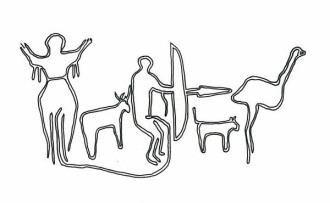 Algerian stone drawing, Paleolithic, located at Tiout in the Saharan Atlas mountains of North Africa.
Algerian stone drawing, Paleolithic, located at Tiout in the Saharan Atlas mountains of North Africa.
From 25,000 years of art, there are around 15 images that are clearly male. This male imagery from the Paleolithic is usually associated with hunting. We see these often roughly-engraved or unclear figures knocked down to the ground by animals, being chased by them, or successful in the hunt. Images were often engraved on animal bone or antler - trophies of the hunt. If masculinity was defined in terms of hunting, then we would also expect the penis - the male symbol - to appear on hunting tools. The phallus may have represented the power of men to overcome the wild beast. Also, success in the hunt may have translated into success in acquiring access to sex with women. Six phallic-shaped objects have been found, and the phallus was engraved on pierced batons made from antler or bone - tools probably used to increase the distance a spear can be thrown.
Women were associated with hunting in a variety of ways, including hunting magic. In this Algerian drawing there is a connecting line between the woman's vulva and the man's penis. It's as if the power from her strengthens his ability to kill the ostrich.


